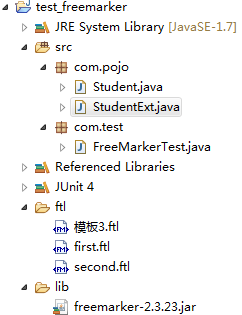freemarker页面静态化
1、工程结构

2、
Student
public class Student { private int id; private String name; private String address; public Student() {} public Student(int id, String name, String address) { super(); this.id = id; this.name = name; this.address = address; } // getter和setter方法省略 }
StudentExt
public class StudentExt { private String title; private Student student; public String getTitle() { return title; } public void setTitle(String title) { this.title = title; } public Student getStudent() { return student; } public void setStudent(Student student) { this.student = student; } }
FreeMarkerTest
package com.test; import java.io.File; import java.io.FileWriter; import java.io.Writer; import java.util.ArrayList; import java.util.HashMap; import java.util.List; import java.util.Map; import org.junit.Test; import com.pojo.Student; import com.pojo.StudentExt; import freemarker.template.Configuration; import freemarker.template.Template; public class FreeMarkerTest { @Test public void testFreeMarker() throws Exception { Template template = getTemplate("first.ftl"); // 第七步:创建模板需要的数据集。可以是一个map对象也可以是一个pojo,把模板需要的数据都放入数据集。 Map<String, Object> root = new HashMap<>(); root.put("hello", "hello freemarker"); // 第八步:创建一个Writer对象,指定生成的文件保存的路径及文件名。 Writer out = new FileWriter(new File("D:\\temp\\html\\first.html")); // 第九步:调用模板对象的process方法生成静态文件。需要两个参数数据集和writer对象。 template.process(root, out); // 第十步:关闭writer对象。 out.flush(); out.close(); } @Test public void testFreeMarker2() throws Exception { Template template = getTemplate("second.ftl"); // 第七步:创建模板需要的数据集。可以是一个map对象也可以是一个pojo,把模板需要的数据都放入数据集。 StudentExt s = new StudentExt(); s.setTitle("生成静态网页"); Student stu = new Student(); stu.setId(1); stu.setName("张三"); stu.setAddress("深圳南山软件园"); s.setStudent(stu); // 第八步:创建一个Writer对象,指定生成的文件保存的路径及文件名。 Writer out = new FileWriter(new File("D:\\temp\\html\\second.html")); // 第九步:调用模板对象的process方法生成静态文件。需要两个参数数据集和writer对象。 template.process(s, out); // 第十步:关闭writer对象。 out.flush(); out.close(); } @Test public void testFreeMarker3() throws Exception { Template template = getTemplate("模板3.ftl"); // 第七步:创建模板需要的数据集。可以是一个map对象也可以是一个pojo,把模板需要的数据都放入数据集。 Map<String, Object> root = new HashMap<>(); Student stu = new Student(1001, "张三", "地球"); Student stu2 = new Student(1002, "李四", "火星"); Student stu3 = new Student(1003, "小明", "不详"); Student stu4 = new Student(1004, "小明", "不详"); Student stu5 = new Student(1005, "小明", "不详"); Student stu6 = new Student(1006, "小明", "不详"); List<Student> studentList = new ArrayList<>(); studentList.add(stu); studentList.add(stu2); studentList.add(stu3); studentList.add(stu4); studentList.add(stu5); studentList.add(stu6); root.put("title", "hello freemarker"); root.put("student", stu); root.put("studentList", studentList); // 第八步:创建一个Writer对象,指定生成的文件保存的路径及文件名。 Writer out = new FileWriter(new File("D:\\temp\\html\\静态页面3.html")); // 第九步:调用模板对象的process方法生成静态文件。需要两个参数数据集和writer对象。 template.process(root, out); // 第十步:关闭writer对象。 out.flush(); out.close(); } private Template getTemplate(String templateFileName) throws Exception { // 第一步:把freemarker的jar包添加到工程中 // 第二步:freemarker的运行不依赖web容器,可以在java工程中运行。创建一个测试方法进行测试。 // 第三步:创建一个Configuration对象 Configuration configuration = new Configuration(Configuration.getVersion()); // 第四步:告诉config对象模板文件存放的路径。 configuration.setDirectoryForTemplateLoading( new File("D:\\oy_workspace\\eclipse_javaee_win64_workspace\\test_freemarker\\ftl")); // 第五步:设置config的默认字符集。一般是utf-8 configuration.setDefaultEncoding("utf-8"); // 第六步:从config对象中获得模板对象。需要制定一个模板文件的名字。 // eclipse不支持*.ftl文件,可以将第三方提供的插件freemarker-ide-0.9.14复制到eclipse的dropins目录下 Template template = configuration.getTemplate(templateFileName); return template; } }
first.ftl
${hello}
second.ftl
<html>
<head>
<meta http-equiv="Content-Type" content="text/html; charset=UTF-8" />
<title>${title}</title>
</head>
<body>
<label>学号:</label>${student.id}<br>
<label>姓名:</label>${student.name}<br>
<label>住址:</label>${student.address}<br>
</body>
</html>
模板3.ftl
<html>
<head>
<meta http-equiv="Content-Type" content="text/html; charset=UTF-8" />
<title>${title}</title>
</head>
<body>
<label>学号:</label>${student.id}<br>
<label>姓名:</label>${student.name}<br>
<label>住址:</label>${student.address}<br>
</body>
列表展示:
<table border="1" bordercolor="blue" cellspacing="0" width="50%">
<th>
<td align="center">学号</td>
<td align="center">姓名</td>
<td align="center">住址</td>
</th>
<#list studentList as stu>
<#if stu_index%2==0>
<tr style="color:red">
<#else>
<tr>
</#if>
<td align="center">${stu_index}</td>
<td align="center">${stu.id}</td>
<td align="center">${stu.name}</td>
<td align="center">${stu.address}</td>
</tr>
</#list>
</table>
</html>
posted on 2019-11-24 20:17 wenbin_ouyang 阅读(342) 评论(0) 收藏 举报



 浙公网安备 33010602011771号
浙公网安备 33010602011771号